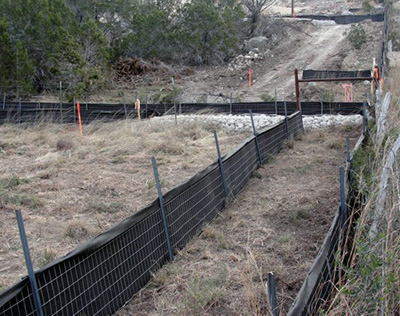Save Your Soil
Do not clear cut the entire construction site!

Damage to your investment or water quality downstream from your property can be swift and substantial during the construction phase of a development. Develop and implement an erosion and sediment control plan before construction of a development begins, to avoid high costs associated with remedies for erosion and soil loss once it is undercutting your site. Proactive methods will also prevent violations of federal, state, and local regulations governing storm water pollution on areas that exceed one acre of disturbance.
Readily available technical guidelines specify many structural controls for handling erosion and sediment once land is disturbed. However, there are several smart, money-saving practices that can be employed to prevent pollution from a construction site and avoid fines or work stoppages:
- Phase construction site work into natural drainage areas to minimize the soil areas exposed at any one time. Use topographically low areas as places to install sediment traps or sediment ponds.
- Divert upland runoff around your construction site whenever possible so upstream runoff can flow on without picking up loose soil from your disturbed and exposed soil
- Shield and protect sensitive features like canyon rimrock, wetlands, and karst recharge areas from disturbed site run off and divert runoff away from these features whenever practical.

- Do not clear cut a site. Preserve existing ground cover, trees, and shrubs when the site plan does not require specific landscape changes. If topsoil needs to be removed for grading or surface development, stockpile topsoil that must be removed for later re-use to stabilize and re-vegetate the site. Likely the best soil to stimulate re-growth of ground cover and stabilization is the native soil and not soil imported from elsewhere at a high cost.
- County requirements establish setbacks (also known as creek buffers or critical water quality zones) on both sides of waterways. Within setbacks, construction is generally prohibited. Preserving all natural vegetation near all waterways is a key measure that results in low impact development and preservation of water quality.
- Sequence construction work from lower elevations first to upgradient locations last, stabilizing and re-vegetating disturbed areas immediately after grading work is completed. Whenever feasible, "rough cut" water quality and detention ponds first in sequence to allow these impoundments to collect sediment.

- In project planning, consider the time of year when site disturbance is completed and when re-vegetation will occur. Re-vegetation or other soil stabilization methods are required promptly following the end of construction regardless of time of year. To achieve a low impact and higher water conservation, avoid the need to plant seed and irrigate disturbed areas in the hottest time of the year. Plant native, drought resistant grasses when it will readily germinate. Otherwise, plant seasonally appropriate grasses to establish temporary cover and follow with native, drought resistant grasses when the appropriate season arrives.
